MXA INTERVIEW: JOHN DOWD WAS TRULY THE JUNKYARD DOG
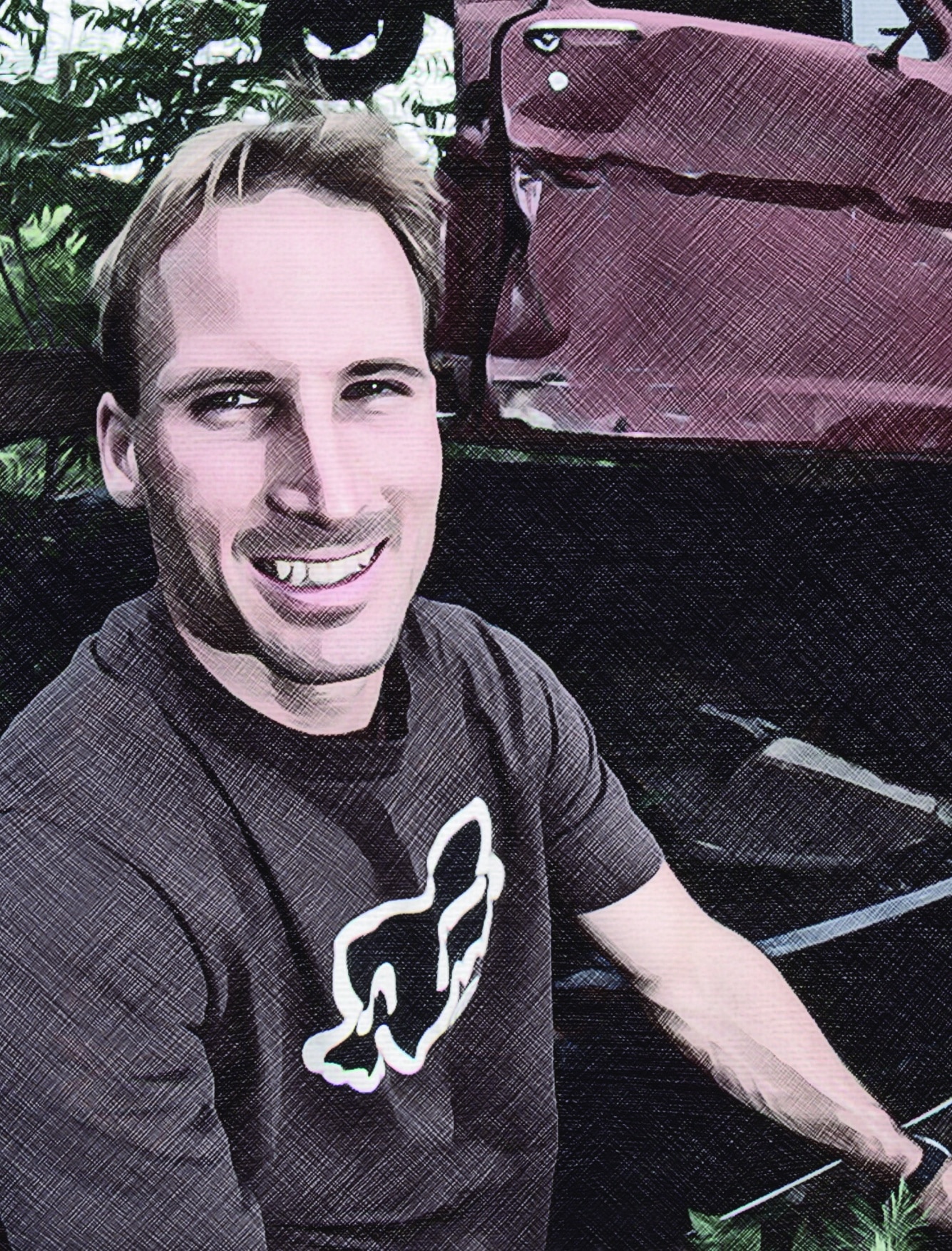
BY JIM KIMBALL
JOHN, YOU WERE 20 YEARS OLD WHEN YOU DID YOUR FIRST MOTOCROSS RACE. I was that guy who did not know anything about motocross. One of my friends told me that there was racing in Southwick, and I went to watch him race and was awestruck. I said, “This looks awesome. I have to try this!” I was almost 21 when I did my first Open Novice race.
OBVIOUSLY, YOU HAD WHAT IT TOOK TO RACE MOTOCROSS. I don’t know specifically what it was. A little bit of raw talent—and some people say it was a lot of heart. My parents did not help me. I saved up and bought my first bike. It was a Honda CR500. The guy that I bought it from used to ride it in the woods.
WHAT ELSE STANDS OUT FROM THAT FIRST DIRT BIKE? My bike was completely clapped out. I crashed a lot. I did not know about throttle control at all. I can’t believe I made it through those first couple of years. I was a menace. There was one friend of mine who was an expert, and all I could think about when we were practicing was, “If you’re going that fast, I am going that fast.” That was my mentality; I didn’t know any better.
THAT’S A LOT DIFFERENT FROM TODAY WHEN SO MANY KIDS GET A NEW DIRT BIKE EVERY YEAR. My parents did not have a lot of money. Nothing was handed to me. I was working when I was in seventh grade. I used to pedal my bicycle to the junkyard, and my dad would pay me to take parts off of cars. I was used to working for whatever I wanted. I could see how much work I did in a week at the junkyard and compare that to how much I made by winning the Expert class. I thought, “Man, racing is cool. They give you money if you do well; this is way better than working all week.” That was probably some of my driving force.
“MY PARENTS DID NOT HAVE A LOT OF MONEY. NOTHING WAS HANDED TO ME. I WAS WORKING WHEN I WAS IN SEVENTH GRADE. I USED TO PEDAL MY BICYCLE TO THE JUNKYARD, AND MY DAD WOULD PAY ME TO TAKE PARTS OFF OF CARS.”
WHEN DID YOU BEGIN TO GAIN SPONSORSHIP? I managed to get a couple Team Green deals over the years. If you were racing local and could win races and possibly a Regional Championship, they were all about it. But, I was older than the other riders, so I never expected to get help or sponsors. That was never in my vision. These days, kids start racing on little bikes and are already saying, “I am going to go to Loretta’s. I am going to go to Mini-O’s.” I did not have any of those experiences. I just thought, “I am old and just having fun. No one is ever going to notice me.” So, when I got a little help from Team Green, I was like, “This is awesome.”
 John Dowd in 1993.
John Dowd in 1993.
THEN YOU WON THE 1991 HANGTOWN NATIONAL AS A PRIVATEER. That was hardly a motocross. That was like the Blackwater 100 off-road race. I recently saw a video clip of that race and was amazed we could make it through a whole moto. I could not believe the rivers that we were crossing. I was one of the luckier guys, because my bike kept running. I credit a lot of that to racing in the New England area. We raced a lot of wet, sloppy races. We weren’t always cutting holes in our air boxes to get more power; we were making sure the thing kept running. I never got new bikes, so my bikes had to last a long time. They had a rider’s meeting before the Hangtown National race, and they were talking about canceling it. I was one of the few guys who wanted to race. I needed to race so I would have enough money to drive home. I literally had $100 on me. I was in California and needed to get home.
YOU WERE ON TEAM GREEN BUT RACED A HONDA AT HANGTOWN. HOW DID THAT HAPPEN? That was weird. The Honda was the only bike in my entire career that I never really rode, but I did in 1991. I decided that I wanted to try to do the 250 Nationals that year, and Team Green would not back me if I was doing them. A Honda dealer in the Boston area said they would help me with a couple of bikes, and I could pay for them at the end of the year. I could do the Nationals with them backing me. That is how it started. I went out to Hangtown and I won, which was my big, amazing moment.

HOW LONG DID YOUR “BIG AMAZING MOMENT” LAST? Not very long, which was a bummer, as I just started to get noticed. Everyone was asking, “Who is this guy?” But it fell apart quickly when I broke my collarbone after that at the New Jersey Supercross. Then, the very next National I went to was Red Bud, and I broke my leg. By then I was 26 years old, and at that time, at 26, you were washed up. I only had that one amazing one-moto wonder win at Hangtown. Later in my career, I was able to back it up with some other good results, but at that point, that was all I had. I was pretty much forgotten about that year. I never believed that I could get somewhere in racing, and I never thought I could get a factory ride.
BUT LATER YOU DID GET A FACTORY RIDE. But first, I returned to Team Green because I committed to staying in New England. I got better and won Championships. Then, in 1993, I was able to get out and do a couple of Nationals and a few 125 Supercross rounds. I stuck my nose in there again, and that is how I got a decent deal with Boyesen Yamaha for 1994.
“EVERYONE WAS ASKING, “WHO IS THIS GUY?” BUT IT FELL APART QUICKLY WHEN I BROKE MY COLLARBONE AFTER THAT AT THE NEW JERSEY SUPERCROSS. THEN, THE VERY NEXT NATIONAL I WENT TO WAS RED BUD,
AND I BROKE MY LEG.”
THAT’S WHEN FANS BEGAN TO RECOGNIZE YOUR NAME OUTSIDE OF NEW ENGLAND. 1994 was an interesting year. I really started coming around physically. I started feeling good about myself again, and I had some pretty good 500 rides in 1993. I started gaining confidence. Also, Boyesen really stepped up that year. They decided to pay expenses for me to race the 250 Nationals, so that was the first year that I got to do the full season. A lot of people say that you have to race with the fast guys to be a fast guy. That’s true. You definitely learn to go faster when you are riding with the fast guys. I learned a lot. That was when Mike Craig had a falling out with Team Yamaha. I was fourth in 250 points as a privateer at that point.
I got the call from Yamaha manager Keith McCarty asking if I wanted to ride Craig’s bike. There were only three races left that year. I was like a kid in a candy store. I did not even ask about any details. They allowed me to race with my Boyesen Yamaha graphics. The bike was only worked on in the Yamaha pits. It never came to my truck. They did all the work. My mechanic would just go with me to the start line and hold the pit board. Everything else was done by the Yamaha guys. We were not really allowed to know anything about anything!
YOU WON THE 250 MILLVILLE NATIONAL THAT YEAR. I remember that race clearly. It was really my first legitimate win. LaRocco beat me in the first moto by 20 seconds, but the second moto, Mike got a poor start. I was feeling the flow, and late in the moto, with three or four laps to go, he caught me. He was literally right on my rear fender for the last couple laps, and I held him off for the finish. LaRocco was pretty dominant that year, and I beat him.
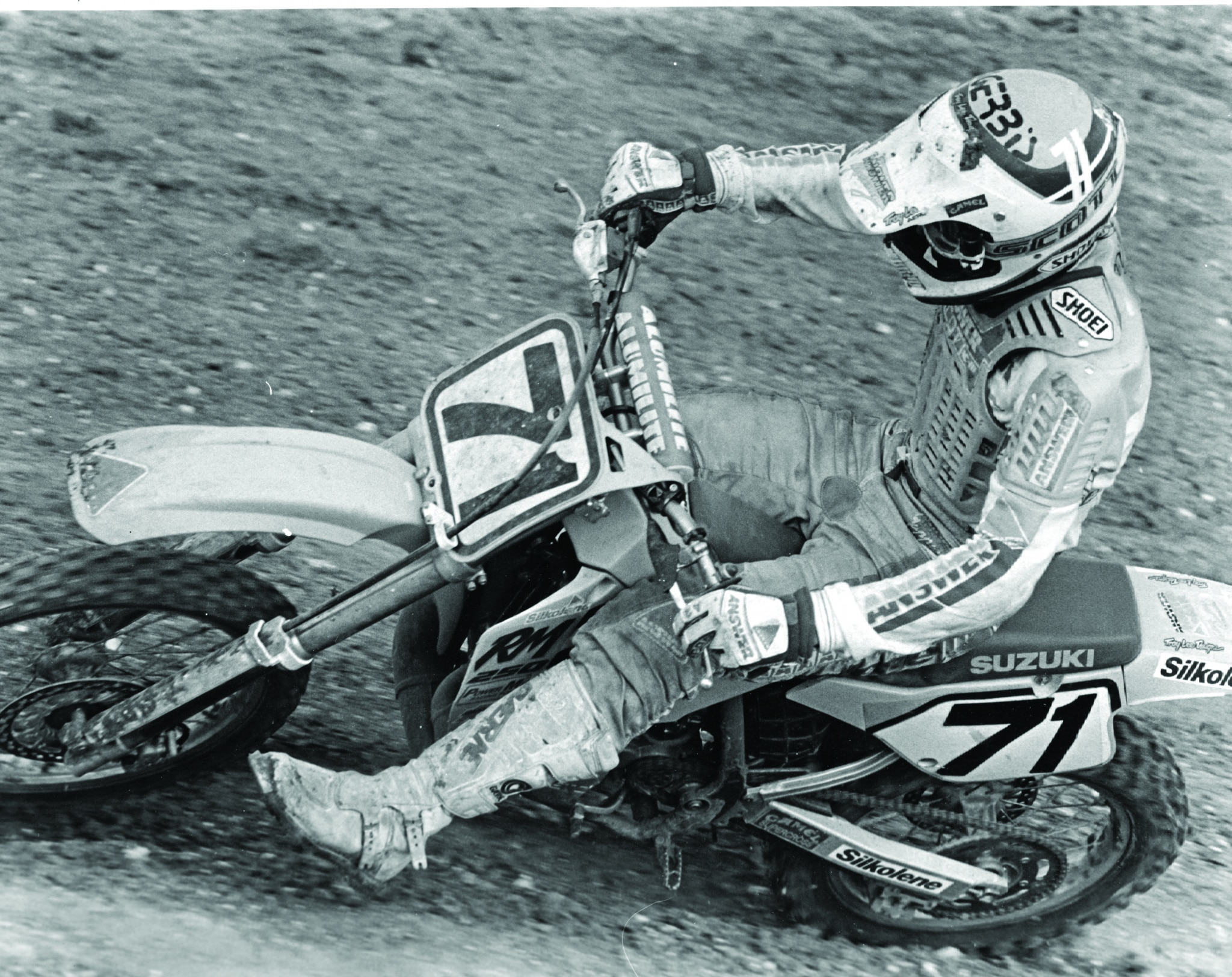 John Dowd on a Suzuki in 1989.
John Dowd on a Suzuki in 1989.
WAS YAMAHA TRYING TO SIGN YOU FOR 1995 AFTER THAT WIN? They had originally told me that this deal “does not mean you are getting a deal for next year; it is just for this year.” After Millville, we went to Binghamton, and I won both motos that day. At that point, the Yamaha guys were blown away! I ended up second in points that year to LaRocco, so that was my first true solid year. That was a turning point for me in my life and my career.
IS IT TRUE THAT YOU NEVER HAD MORE THAN A ONE-YEAR CONTRACT? I always had one-year deals. I hate to say this, but no one ever really planned on me staying fast as long as I did. And that included me. I never really knew how long I was going to be able to keep it up. Every year I was amazed that I was able to pull off the success that I pulled off.
HOW DID YOU END UP IN THE 125 CLASS IN 1996? It was due to Damon Bradshaw coming back to Yamaha. They said, “We have to hire Bradshaw.” Keith came to me and said that he was sorry, but that he could not keep me on the team. I was mad. In my mind, I felt that I could beat Bradshaw. I had a mission at that point. They needed to find a 125 guy, and I said, “Put me on a 125. I can ride that thing. I used to race 125s.” They gave me a shot, and I won the 1996 Atlanta and Pontiac 125 East races and ended up second in the 1996 AMA 125 National series in 1996 behind Steve Lamson. In 1997 they put me back in the 250 class.
WHAT WAS THE 250 SERIES LIKE IN 1997? I went back and forth with Jeff Emig all year, ultimately finishing second in the 250 Nationals. I won a couple of motos, and we had some wicked battles. It was a really cool year, except for the fact that I was second again; I was forever the bridesmaid. I hated Emig because he had such a perfect year. He never got a flat tire and never went down. I beat him sometimes and was keeping him in sight in the points, but he had a perfect year.
AND IN 1998, YOU MOVED BACK TO THE 125 CLASS. I ended up winning the 125 West Supercross Championship. I was never really that good at Supercross. Then I finished second to Ricky Carmichael in the 1998 AMA 125 National Motocross Championships. I actually beat Ricky at Southwick, and that is one of my claims to fame. I know he blew up his engine in the first moto, but I had actually passed him a couple of laps before his engine blew up, and then I beat him straight up in the second moto. I never even saw him. I took the holeshot, and I won by 20 seconds.
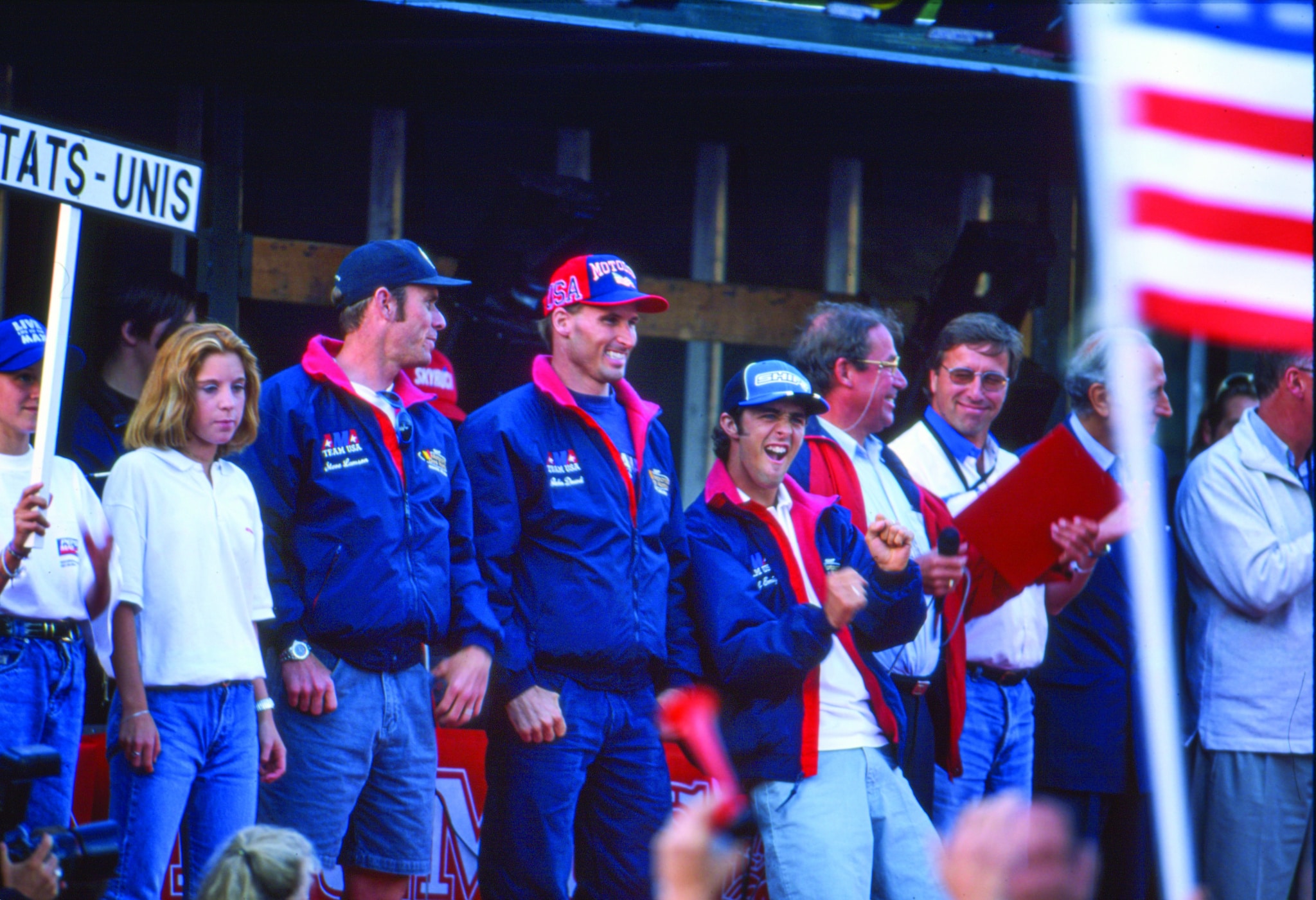 The 1997 Motocross Des Nations USA team of Steve Lamson, John Dowd and Jeff Emig.
The 1997 Motocross Des Nations USA team of Steve Lamson, John Dowd and Jeff Emig.
YOU WERE ALWAYS IN SUCH AWESOME SHAPE. HOW DID YOU TRAIN? I grew up my whole life working outside in the summer heat. We never had air conditioning in our house, and none of the cars we drove had AC. My dad did excavations when I first started racing, and I was the shovel guy. I was in a hole all the time shoveling out. I looked at everything I did as training. Back then, nobody really had trainers; it is quite different now.
I used to mountain bike. I used to run. I worked hard. I believe that the reason Doug Henry and I came out of nowhere as privateers was because we were in shape. But, those days are over now. All of the young guys coming up now ride and train at these facilities. The sport has changed. If you want to go anywhere, you have to be one of those guys at the training facilities.
“I HAD A MISSION AT THAT POINT. THEY NEEDED TO FIND A 125 GUY, AND I SAID, “PUT ME ON A 125. I CAN RIDE THAT THING. I USED TO RACE 125S.”
IN 2000 YOU WENT TO FACTORY KAWASAKI. WHY DID THINGS END AT YAMAHA? 1999 was a tough year for me. I had one really bad injury where I broke my shoulder at Daytona. I got a couple of podiums in Supercross that year and was truly learning Supercross. It took six months before I could even ride again, and the shoulder was just really weak. I did not start racing until outdoors. I missed the first handful of races and then tried to race but could not hang on. The year started out great, but then as the season went on, it fizzled.
I had been getting podiums in 250 Supercross, but from that point on, I never really got there again. I was getting pretty old by then, too. I was 35. Yamaha had some new riders in mind, like David Vuillemin and Jeremy McGrath with Chaparral. There was no more room in the program for me. There were not really any hard feelings, but I was bummed because I always felt like I had a home there.
BUT KAWASAKI FELT YOU WERE WORTH TAKING A CHANCE ON. Luckily, Bruce Stjernstrom stepped up at the time and said, “Hey, I know you got hurt. We are willing to give you a shot and see how it goes.” Unfortunately, 2000 ended up not being a great year either. I broke my back towards the end of the Supercross season. I did not have to have surgery or anything but was out again for months. When I tried to ride later in the season, I was junk.
At the end of 2000, I got to the point where I was going to retire, because I was not having any fun. Everyone was still expecting me to go out and win and podium. My body was not doing it anymore. After that, Kawasaki obviously did not want to renew my contract.
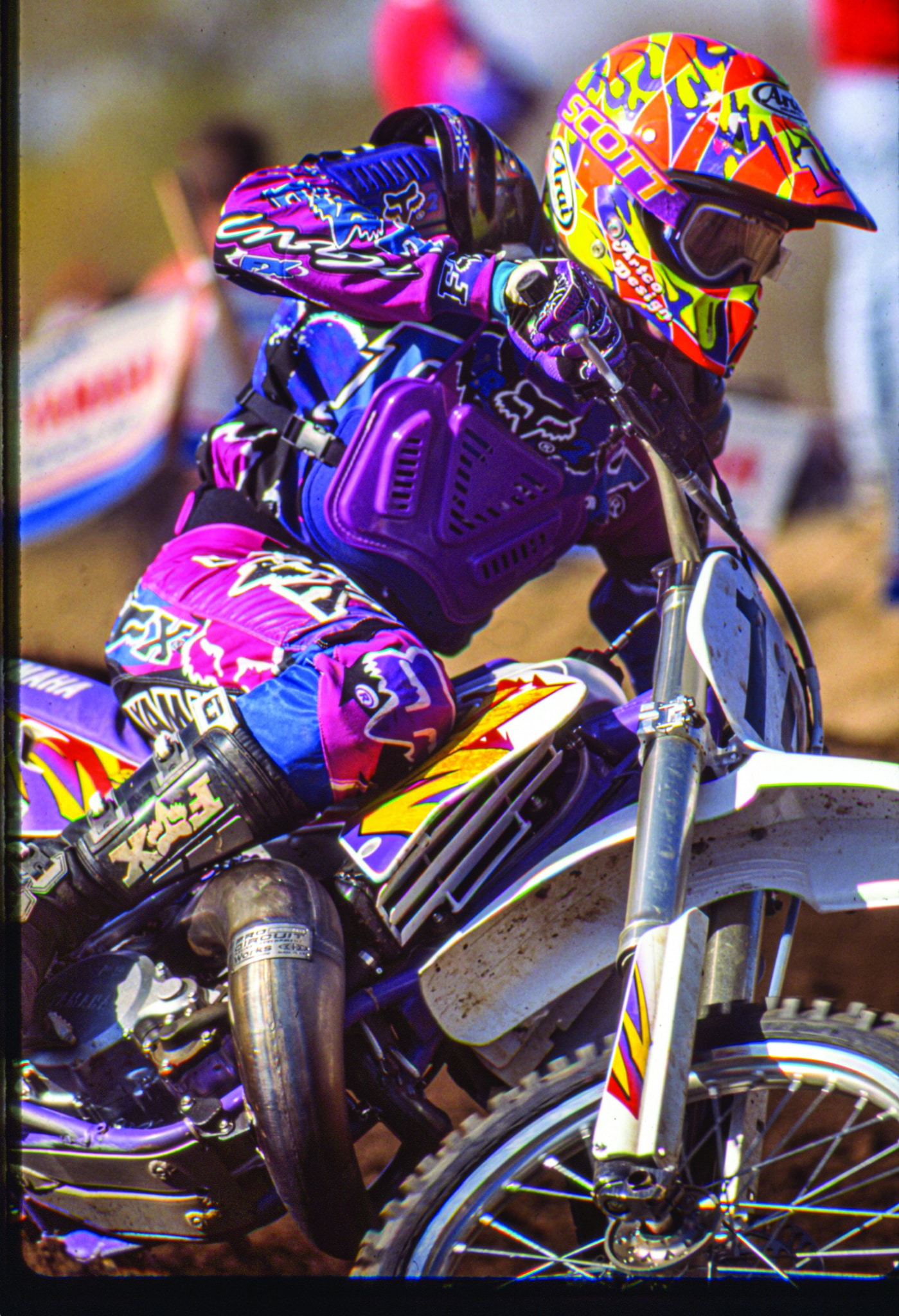
BUT, YOU CAME BACK TO RACE THE FOLLOWING YEAR. That was an awesome time! A couple of my local buddies put together this deal with Jeff Cernic to race outdoors. He and KTM team manager Ron Heben made it happen. My mechanic and I were privateers again. Ron Heben was so cool, helpful and easy-going. It turned my racing mind around. All of a sudden, I started having fun again. I was on this weird bike—a KTM 520 four-stroke with no shock linkage and air forks. Everybody was saying, “I can’t believe you are riding that thing.” But, it really was not half bad.
 John Dowd’s Cernics 2001 KTM 520 four-stroke.
John Dowd’s Cernics 2001 KTM 520 four-stroke.
IT BROUGHT BACK THE FUN AGAIN, DIDN’T IT? Yes, it was crazy to think that you could race motocross with no linkage. We got the bike to work pretty well. I loved the thing and thought it was awesome. I got second overall at Southwick that year on that 520. That was 2001, and then in 2003, I got second overall on the KTM 250 two-stroke. It was so fun. No one ever expected that! There was no pressure, and we were just racing to be racing. I started having some good results, and it became really fun again, which was what I was missing towards the end of 2000. I didn’t ride Supercross on it; it was definitely not a Supercross machine. The bike was fun but also very heavy.
“I WAS UP THERE WITH ALL THE BIG GUYS. I HAD QUITE A CROSS-GENERATIONAL CAREER GOING. I RACED WITH BOB HANNAH, RICK JOHNSON, JEFF WARD, JEAN-MICHEL BAYLE, MIKE KIEDROWSKI, MIKE LAROCCO, RICKY CARMICHAEL, JAMES STEWART, RYAN DUNGEY AND RYAN VILLOPOTO.”
YOU COMPETED WITH SO MANY STARS FROM 1987 TO 2013. I have a little fact for you on that note. The first National I ever did was at Southwick in 1987, and I got third somehow—out of the blue. I raced with Bob Hannah during his last year racing. In one of the motos, I remember seeing Rick Johnson with the #1 on his back. I was just freaking out. I was up there with all the big guys. I had quite a cross-generational career going. I raced with Bob Hannah, Rick Johnson, Jeff Ward, Jean-Michel Bayle, Mike Kiedrowski, Mike LaRocco, Ricky Carmichael, James Stewart, Ryan Dungey and Ryan Villopoto. That was four or five generations of guys who have come and gone. I hung in there for a long time. I just loved riding.
FUN APPEARS TO HAVE BEEN KEY TO YOUR RACING SUCCESS. That was the most important thing for me. I needed to have fun; otherwise, it was hard. I had a family all through it, and I knew when I was going away racing I was giving up something to be there. So, if I was not having fun with it, it made things really difficult.
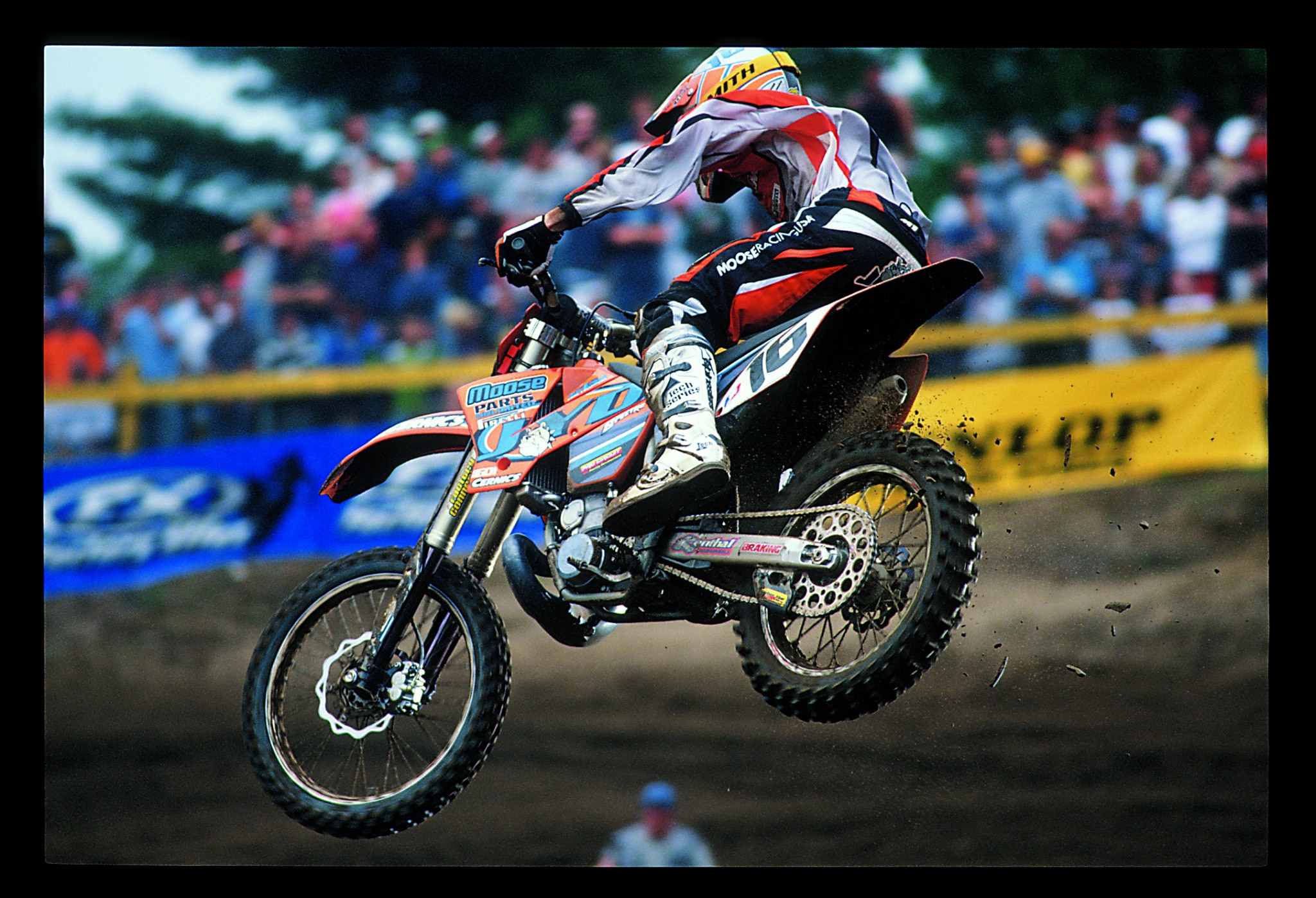
YOU HAVE BEEN DOING SOME VET RACING IN PAST YEARS. I had gotten into the Vet Motocross des Nations, and I did that for six years. That was really fun, but by the end of the sixth year, I was not really running near the front anymore. They had moved some of the age limits down significantly. Then, they changed it to like five motos per class, per weekend. So, the last year I went, I was racing a lot. I literally rode about 10 serious motos. This year, I turned 55, and I would have been 15 years older than guys who would be in the 40-plus class. I made a career of ignoring my age, but the reality is that I am getting pretty old. When I was 35, I podiumed some races. When I was 40, I was still solid physically. But now, at 55, my body is just not doing it anymore.
WHAT IS YOUR BIGGEST RACING ACHIEVEMENT IN MOTOCROSS? I would have to say winning the 1998 125 West Supercross, because Supercross was not my thing. I don’t know how I managed to squeak that one out. It was really due to the guys at Yamaha steering me in the right direction. I was the kind of guy who if they said, “Try it this way,” I would do it. I was not a know-it-all or too set in my ways. I was always pretty open-minded to improve my racing. I was the average joe, but somehow I got it done. I never felt like Carmichael or McGrath, but I managed to get up there and race with them. I was always very thankful. Every time I had a good race, I had a smile on my face from ear to ear, and it was easy for me. I just loved being there. I think that is how fans looked at me.





Comments are closed.